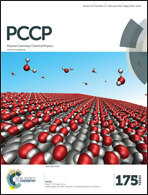A new medium for triplet–triplet annihilated upconversion and photocatalytic application†
Abstract
Since the triplet–triplet annihilated upconversion (TTA-UC) materials work efficiently only in degassing organic solvents, it is of significance to find a new medium without toxicity and volatility and that promotes TTA-UC. Here, we firstly reported the effect of an OH-containing medium on low power upconversion and found that in alcohol solvent containing β-cyclodextrin (β-CD), the phosphorescence lifetime (τp) of the sensitizer (PdTPP) and the fluorescence quantum yield (Φf) of the acceptor (DPA) were enhanced with the increase in the number of OH-groups of the medium. A large triplet–triplet quenching constant (kq, 1.91 × 109 M−1 s−1) and high upconversion efficiency (ΦUC, ∼36%) of PdTPP/DPA were obtained under the excitation of a diode laser (532 nm, 60 mW cm−2). Under our green-to-blue upconversion irradiation, in a demonstration experiment the photocurrent was recorded at 0.09 μA cm−2, resulting from photocatalytic water splitting by a Cd0.7Zn0.3S photoanode and a Pt counter-electrode in a photoelectrochemical cell. The importance of this study suggests that upconversion-powered photoelectrochemistry possesses potential application for hydrogen generation from water under excitation of sun energy.


 Please wait while we load your content...
Please wait while we load your content...